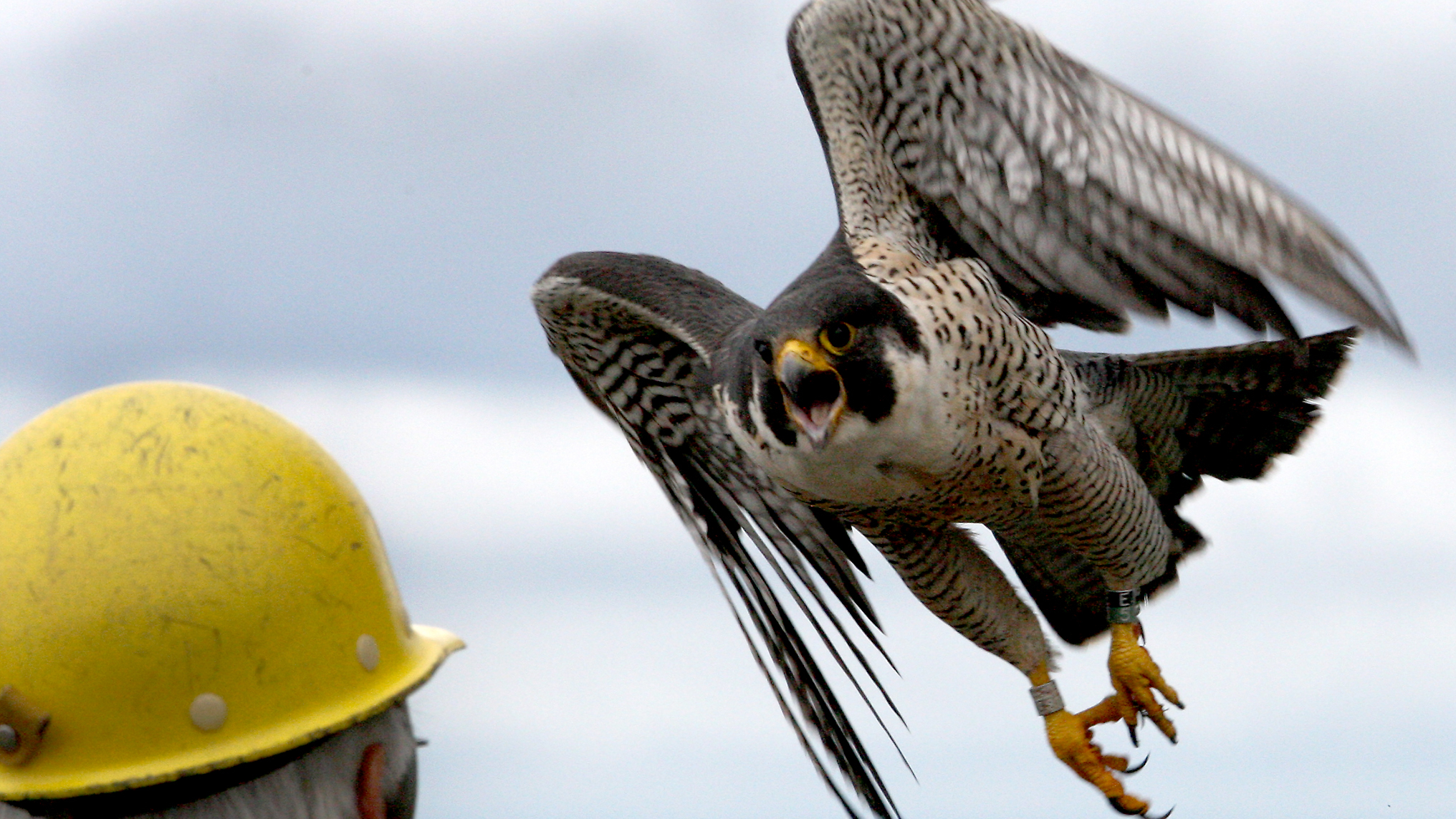
What's the fastest airborne animal?
Which animal moves fastest through the skies?

The cheetah is well-known for being the fastest creature on land, but the animal kingdom is not limited to Earth's surface. What is the fastest flying animal? And what biological features enable its speed?
Nature's swiftest jet-setter is the peregrine falcon (Falco peregrinus). "Peregrinus" is the Latin word for "traveler," a fitting moniker given that the raptors can migrate up to 15,550 miles (25,000 kilometers) in a roundtrip — one of the longest migrations in North America, according to the Nature Conservancy Indeed, peregrine falcons are global birds, found on every continent except Antarctica, the National Wildlife Federation noted.
Peregrines hunt for prey from great heights, either from the air or a high perch. When they find a target, they plummet at high speeds, attacking with a clenched foot to stun or kill prey with the impact, Hein van Grouw, senior curator of London's Natural History Museum's bird group, told Live Science in an email. During a dive — known as a stoop — a peregrine is estimated to reach speeds of up to about 200 mph (320 km/h), according to a 2018 study in the Journal of Comparative Physiology A, which not only make peregrines the world's fastest birds but also the world's fastest animals, Britannica noted.
Experimental dives suggested that peregrines may even reach speeds of up to 242 mph (389 km/h), according to Guinness World Records. In a series of dives in 1999, a female peregrine falcon named "Frightful," owned by aviator and falconer Ken Franklin of Friday Harbor, Washington, set the world record after she was released from a plane about 17,000 feet (5,182 meters) above sea level. The 6-year-old Frightful was about 16 inches (40.6 centimeters) long, weighed about 2.2 pounds (1 kilogram) and had a wingspan of about 41 inches (104 cm), Guinness World Records noted.
Related: What is the fastest animal on Earth?
To measure Frightful's speed, Franklin attached a 4-ounce (113.4 grams) computer chip taken from a skydiver's recording altimeter-computer to Frightful's tail feathers. Franklin then measured how far Frightful dived during a certain span of time. Franklin and a cameraman also wore altimeters (devices that measure altitude) when they skydived with Frightful during her stoops. The data from all the devices were compared after the dives, Guinness World Records reported.
So, what anatomical features help peregrine falcons achieve these great speeds?
Sign up for the Live Science daily newsletter now
Get the world’s most fascinating discoveries delivered straight to your inbox.
Peregrine falcons have pointed wings that resemble those of fighter jets. This shape reduces the amount of drag they experience from the air, which helps peregrines fly quickly, Ed Drewitt, a zoologist and peregrine falcon researcher based in the United Kingdom and author of "Urban Peregrines" (Pelagic Publishing, 2014) told Live Science in an email.
Peregrines have muscular, teardrop-shaped bodies that also help streamline the birds to "reduce drag and help it drop like a bullet," Drewitt said. In addition, their feathers are remarkably tightly packed and stiff in structure when compared with other falcons, "probably to reduce drag and make it go more smoothly through the air," van Grouw said.
Peregrine nostrils, meanwhile, possess a system of little knobs within them that are thought to act as baffles — a structure that regulates the passage of fluids. These knobs work by "reducing the flow of air into their air passages," Drewitt said. This likely helps peregrines breathe during their incredibly fast dives.
The peregrine falcon's breakneck speed helps it hunt — mostly other birds, ranging from prey as small as hummingbirds to as large as sandhill cranes (Grus canadensis), according to the National Wildlife Federation. Scientists have documented about 450 species of birds as their prey in North America, and the number worldwide may be as many as 2,000.
Related: Why are there so many pigeons?
The shape of peregrines is very similar to that of their main prey, common pigeons (Columba livia), also known as rock doves. "Both have evolved alongside each other, one to escape the other and one to catch the other," van Grouw said. "It is interesting that they both get their speed from the same body shape."
Peregrines also eat bats, and occasionally steal prey such as fish and rodents from other raptors.
In fact, while peregrines are the fastest animals to move through the air when they dive, a bat claims the prize as the fastest flying creature on record. Brazilian free-tailed bats (Tadarida brasiliensis) are the world's fastest known fliers, clocking speeds up to 100 mph (160 km/h), Live Science previously reported. That's fast compared with the peregrine falcon's flying speeds, which average 25 to 34 mph (40 to 55 km/h) in traveling flight and 69 mph (112 km/h) while pursuing prey, according to the Cornell Lab of Ornithology.
Originally published on Live Science.











